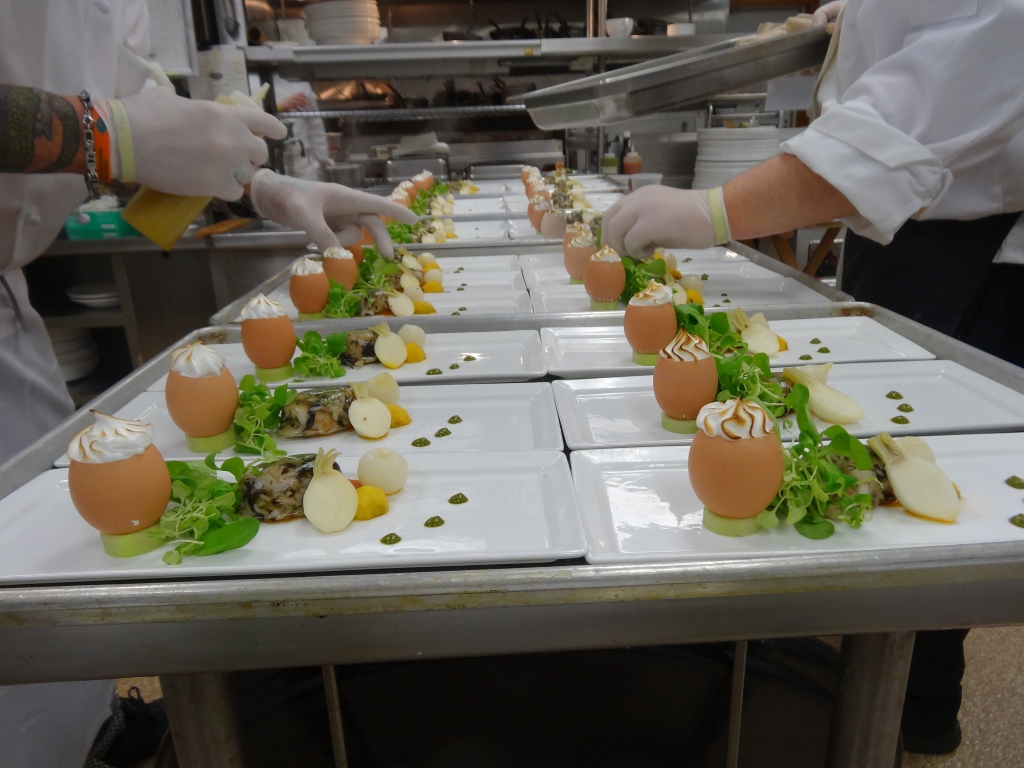
From first-in, first-out in the walk-in cooler to how you fold side towels and where your knives are placed – it is organization that allows a kitchen to run efficiently and keeps the mood and pace of the restaurant in sync. To some, it may seem less significant, but to seasoned professionals – this is the truth of the kitchen. To the novice it may appear the cooks and chefs are plagued by OCD (Obsessive-Compulsive Disorder) but let me be clear: a kitchen without this level of organization will revert to chaos and chaos never wins in the long run.
When a kitchen exudes calm, even when the amount of food prep and the stress of the moment seem over-the-top, it is always a result of organization and attention to detail. Spend time in such a kitchen and you will note how pervasive this attention to detail is. It goes way beyond the typical thoughts about mise en place, it extends much further than having your prep in order, organization becomes a way of life that permeates every detail of a cook’s work and life. When a kitchen is this organized, cooks practice detailed organization without even thinking about it. In fact, you will oftentimes find that this organization extends into their personal lives as well. Attention to detail cannot be turned on and off, so how a cook organizes his or workstation in the restaurant is how he or she will organize their home kitchen, their clothes, books, records, and food supplies. It becomes natural – how he or she lives.
The kitchen is a thing of beauty and intense structure when organization is the rule of thumb. Plating salads for a large group – all the plates are lined up perfectly and ingredients placed in the exact same spot on each plate. Storerooms and coolers are organized so that containers are all pointed in the same direction with labels facing out, sauté pans at a line cooks station are stacked with the handles facing in the same direction, and a cook’s production list is written either in order of work to be done, or in terms of the amount of time each task requires. Throughout the kitchen – this is the rule of thumb: everything has an order, a place, and a time that everyone adheres to.
In the dining room, the same attention to organization must be prevalent. How tables are set, what order is used, in some cases measuring the distance from the edge of the table to the bottom of forks, knives, and spoons; lining up glassware with a taut string to ensure equidistance, where each type of backup glassware and plate is stored, a specific location for pens, candles, salt and pepper shakers, napkins, and menus – it is essential that everything is placed exactly where it should be so that each person can depend on that structure. Lost moments looking for anything out of place is not only inefficient, but also a prime source of frustration.
Orders are always taken in a certain order at the table, entered into the point of sale in that same order, and then delivered with the expectation that each server followed the rules of engagement. If a tray is used, plates are placed on the tray in the order that they will be delivered to guests at that table. It is a synchronized process that leads to consistent, predictable results. Front and back of the house demand this organization if the end result is a smooth operation and happy guest.

Back to the kitchen – if you were to record the workings of a team of line cooks and put the video to music, it would be a symphony that made the connection – not improvisational jazz, pop, or rap. Each cook depends on the next to follow the pre-determined steps, in order, and in sync with the timing orchestrated by the expeditor. The left hand always knows what the right hand is doing. A pivot step from the sauté cook is met with the same from the grill, the center person is strategically placing the vegetable, starch, and sauce on the plate at the same moment as the expeditor waits to adjust a fresh herb, wipe the plate rim, and step aside for the server to pick-up an order while it is at the peak of freshness. It is majestic, inspiring, and almost effortless when organization is the rule that everyone follows.
When a chef talks about those minute details of placement, process, timing, and uniformity – keep in mind what the intended result will be. Chefs work from the end placement backward in establishing those standards – it is quite possibly the most important thing that a professional chef can do. Hire people with the capacity and set the standards of organization that everyone must buy into. Never underestimate just how important this is for the guest, for the demeanor of those who work in the kitchen, for the communication between front and back-of-the-house, and for the success of the restaurant.
PLAN BETTER – TRAIN HARDER
Harvest America Ventures, LLC
www.harvestamericacues.com BLOG
CAFÉ Talks Podcast

Leave a comment